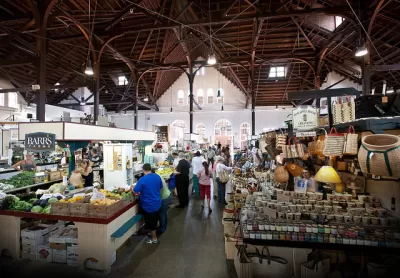Public food markets can be key centers of urban commerce and social life. Late last year, a brainstorming event in London considered how they might evolve to accommodate modern lifestyles and technologies.

More permanent than farmers' markets (though they can assume that role), urban food markets like London's Borough Market and Seattle's Pike Place offer counterpoints to the supermarket mainstream. Louise Marston reports on a event that took place late last year in Borough Market, bringing together "chefs, designers, policy makers, academics and market-goers [...] to explore ideas about what the market of the future might look like."
Marston writes, "The future of food is often treated either as an economic future - a future industry, with associated employment patterns and distribution routes. Or it is forecast as a global, ethical future - a looming crisis of growing population colliding with a growing preference for meat and processed food." Event participants considered a more holistic vision: food as an expression of community.
"There was also a desire to preserve the market as a meeting place, a place of conviviality. Some people wanted to emphasise the role of the market as a place for bartering, exchange and in capturing the full life-cycle of food, including its growing and waste."
Discussion also took place about how the public market—seen as something of a throwback—can be improved by 21st-century technologies. "Drones, hovercraft, helicopters and electric vehicles were all suggested as new ways for food to make its way to and from the market."
FULL STORY: The Future of the Urban Food Market

Alabama: Trump Terminates Settlements for Black Communities Harmed By Raw Sewage
Trump deemed the landmark civil rights agreement “illegal DEI and environmental justice policy.”

Study: Maui’s Plan to Convert Vacation Rentals to Long-Term Housing Could Cause Nearly $1 Billion Economic Loss
The plan would reduce visitor accommodation by 25% resulting in 1,900 jobs lost.

Why Should We Subsidize Public Transportation?
Many public transit agencies face financial stress due to rising costs, declining fare revenue, and declining subsidies. Transit advocates must provide a strong business case for increasing public transit funding.

Wind Energy on the Rise Despite Federal Policy Reversal
The Trump administration is revoking federal support for renewable energy, but demand for new projects continues unabated.

Passengers Flock to Caltrain After Electrification
The new electric trains are running faster and more reliably, leading to strong ridership growth on the Bay Area rail system.

Texas Churches Rally Behind ‘Yes in God’s Back Yard’ Legislation
Religious leaders want the state to reduce zoning regulations to streamline leasing church-owned land to housing developers.
Urban Design for Planners 1: Software Tools
This six-course series explores essential urban design concepts using open source software and equips planners with the tools they need to participate fully in the urban design process.
Planning for Universal Design
Learn the tools for implementing Universal Design in planning regulations.
Caltrans
Smith Gee Studio
Institute for Housing and Urban Development Studies (IHS)
City of Grandview
Harvard GSD Executive Education
Toledo-Lucas County Plan Commissions
Salt Lake City
NYU Wagner Graduate School of Public Service



























